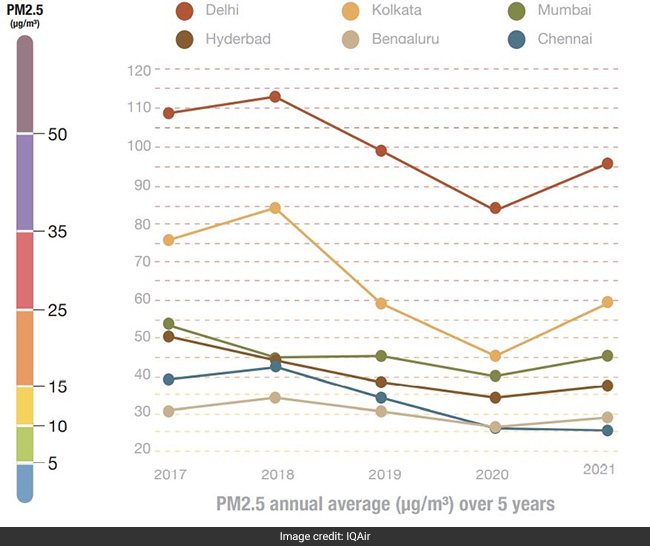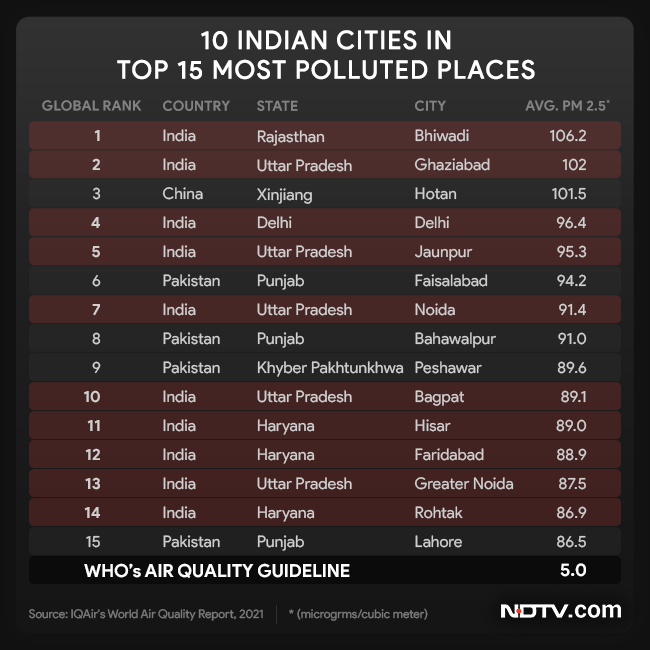Highlights
- India is fifth most polluted among 117 countries, regions and territories
- Delhi is world’s most polluted capital city for the fourth consecutive year
- No cities in India met the WHO air quality guideline of 5 µg/m3 in 2021
New Delhi: The air pollution levels in India worsened in 2021, ending a three-year trend of improving air quality, according to the World Air Quality Report released by IQAir, a Swiss firm on Tuesday (March 22). India is the fifth most polluted country among 117 countries, regions and territories around the world, assessed. The country’s annual average PM2.5 levels reached 58.1 micrograms per cubic meter (µg/m3) in 2021, returning to pre-quarantine concentrations measured in 2019. The WHO recommends that average annual readings of small and hazardous airborne particles known as PM2.5 should be no more than 5 micrograms per cubic meter after changing its guidelines in 2021.
Also Read: No Country Met WHO Air Quality Standards In 2021: Data
Why Does The Report Assess Only PM2.5?
Particulate Matter (PM) 2.5 consisting of fine aerosol particles measuring 2.5 microns or smaller in diameter, is one of six routinely measured criteria air pollutants and is commonly accepted as the most harmful to human health due to its prevalence in the environment and a broad range of health effects.
As per the report,
PM2.5 is generated from many sources and can vary in chemical composition and physical characteristics. Common chemical constituents of PM2.5 include sulphates, nitrates, black carbon, and ammonium. The most common human-made sources include internal combustion engines, power generation, industrial processes, agricultural processes, construction, and residential wood and coal burning. The most common natural sources for PM2.5 are dust storms, sandstorms, and wildfires.
New Delhi, World’s Most Polluted Capital City
The national capital Delhi topped the list of polluted capital cities in the world for the fourth consecutive year. Delhi saw a 14.6 per cent increase in PM2.5 concentrations in 2021 with levels rising to 96.4 µg/m3 from 84 µg/m3 in 2020.
Delhi was followed by Dhaka (Bangladesh), N’Djamena (Chad), Dushanbe (Tajikistan), Muscat (Oman) and Kathmandu (Nepal). All six capital cities reported an average annual PM2.5 concentration above 50 µg/m3.
Also Read: COP26 Aims To Banish Coal. Asia Is Building Coal-Fired Plants To Burn It
Pollution In Central And South Asia
India and Pakistan generally experience the worst air quality in this region, with 48 per cent and 67 per cent respectively of cities with PM2.5 concentrations greater than ten times the 2021 WHO air quality guideline level, stated the report.
In the Central and South Asia region, the most polluted regional city is Rajasthan’s Bhiwadi, followed by Uttar Pradesh’s Ghaziabad on Delhi’s eastern border.
No Cities In India Met The WHO Air Quality Guideline
India was home to 11 of the 15 most polluted cities in Central and South Asia in 2021. No cities in India met the WHO air quality guideline of 5 µg/m3. In fact, in 2021, 48 per cent of India’s cities exceeded 50 µg/m3, or more than 10 times the WHO guideline.
In India, if we look at the annual average of PM2.5, all six metro cities except Chennai saw a rise in air pollution levels last year. Delhi was followed by Kolkata, Mumbai, Hyderabad, Bengaluru and Chennai.
With 63, Indian cities dominate the list of 100 most polluted places. More than half are in Haryana and Uttar Pradesh.
Decoding India’s Perennial Problem Of Air Pollution
Air pollution has a massive impact on human health in India. It is the second biggest risk factor for disease, and the economic cost of air pollution to the Indian economy is estimated to exceed $150 billion dollars annually, states the “Finding Solutions to Air Pollution in India: The Role of Policy, Finance, and Communities,” ORF Special Report.
Major sources of air pollution in India include vehicular emissions, power generation, industrial waste, biomass combustion for cooking, the construction sector, and episodic events like crop burning.
In 2019, the Ministry of Environment, Forest and Climate Change (MoEF&CC) enacted the National Clean Air Program (NCAP). The plan seeks to reduce PM concentrations by 20 per cent to 30 per cent by 2024 in all identified non-attainment cities, increase air quality monitoring, and implement a city, regional, and state-specific clean air action plan as well as to conduct source apportionment studies.
Mentioning the NCAP, the report states,
The lockdowns, restrictions, and resulting economic downturn due to the COVID-19 pandemic have made it difficult to determine the plan’s impact based on air pollution levels alone. A recent report found that apart from city-specific action plans, no other plans have been formulated under NCAP prescribed timelines. Additionally, there is little information about the activities related to the NCAP, making it difficult to dispel the public’s dissatisfaction with the slow progress under the program.
In an effort to address vehicular emissions, especially curtail the contribution to air pollution from motor vehicles, India has adopted vehicle emission standards for new vehicles. The BS-VI standard is currently equivalent to the Euro 6-1 standard and will be equivalent to the Euro 6-2 standard beginning in April 2023.
Also Read: Phase Down From Coal As Main Source Of Energy, Invest More In Renewables: ICMR And Lancet Report
However, Sunil Dahiya, Analyst, Centre for Research on Energy and Clean Air (CREA), believes there exists a gap between the formulation of policies and their implementation. He said,
Continuous dominance of Indian cities in the world’s most polluted cities is a reminder that even though we have started moving on the journey towards clean air through the formulation of policies like NCAP and others, there remains a big gap in the formulation of policies and emission standards and their actual implementation on the ground. Until and unless we move to the emission load cap and reduction approach and limit combustion of fossil fuels, i.e., coal and petroleum products, it will be impossible to provide breathable air to citizens and our cities will keep making into such lists of most polluted cities.
In an exclusive interview with NDTV, Glory Dolphin Hammes, CEO of IQAir North America, rated India’s performance with that of China, the country that has reported significant improvement in air quality. Ms Hammes said,
China is investing heavily in renewable energy sources. They have a plan and commitment to go net-zero and year after year they are investing and putting forth the funds in order to change their energy production from coal and fossil fuels based into solar energy. They are improving the air quality by double digits, every single year. India was on the track to do the same but I don’t know if it’s the investment but it was definitely probably some of these lockdown measures as a result of the pandemic. The lockdown measures really affected how people travelled, if they travelled at all and of course, transportation we know is one of the biggest sources of PM2.5.
Further, when asked what India can do to address the problem of air pollution, Ms Hammes suggested taking a serious look at the modes of transportation and moving towards electric vehicles. She also recommended putting some limitations on other things such as crop burning which also contributes to PM2.5.
Also Read: Decrease In Air Pollution In India During Lockdown Not As High As Thought: Study
NDTV – Dettol have been working towards a clean and healthy India since 2014 via Banega Swachh India initiative, which is helmed by Campaign Ambassador Amitabh Bachchan. The campaign aims to highlight the inter-dependency of humans and the environment, and of humans on one another with the focus on One Health, One Planet, One Future – Leaving No One Behind. It stresses on the need to take care of, and consider, everyone’s health in India – especially vulnerable communities – the LGBTQ population, indigenous people, India’s different tribes, ethnic and linguistic minorities, people with disabilities, migrants, geographically remote populations, gender and sexual minorities. In wake of the current COVID-19 pandemic, the need for WASH (Water, Sanitation and Hygiene) is reaffirmed as handwashing is one of the ways to prevent Coronavirus infection and other diseases. The campaign will continue to raise awareness on the same along with focussing on the importance of nutrition and healthcare for women and children, fight malnutrition, mental wellbeing, self care, science and health, adolescent health & gender awareness. Along with the health of people, the campaign has realised the need to also take care of the health of the eco-system. Our environment is fragile due to human activity, that is not only over-exploiting available resources, but also generating immense pollution as a result of using and extracting those resources. The imbalance has also led to immense biodiversity loss that has caused one of the biggest threats to human survival – climate change. It has now been described as a “code red for humanity.” The campaign will continue to cover issues like air pollution, waste management, plastic ban, manual scavenging and sanitation workers and menstrual hygiene. Banega Swasth India will also be taking forward the dream of Swasth Bharat, the campaign feels that only a Swachh or clean India where toilets are used and open defecation free (ODF) status achieved as part of the Swachh Bharat Abhiyan launched by Prime Minister Narendra Modi in 2014, can eradicate diseases like diahorrea and the country can become a Swasth or healthy India.
[corona_data_new]





























